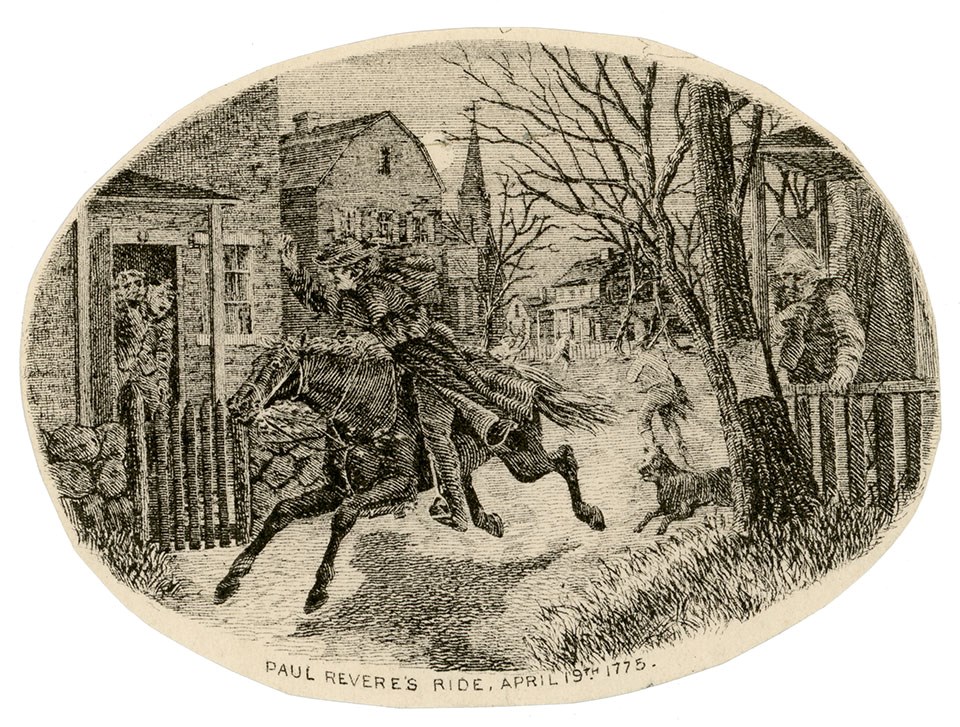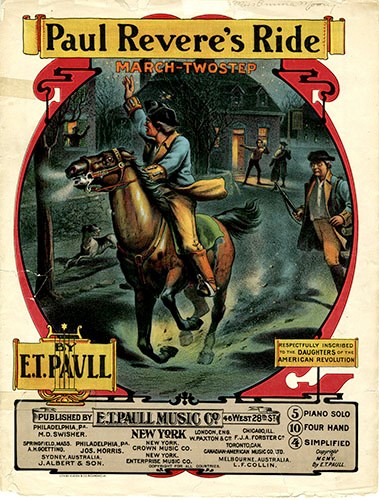The opening lines of "Paul Revere’s Ride" are perhaps the best-known words today of Henry Wadsworth Longfellow. The poem, with its galloping measure and steady rhyme, take the reader through Paul Revere’s urgent ride on the eve of the battle of Lexington and Concord. When it was published in Tales of a Wayside Inn (1863), the poem became "The Landlord’s Tale," with the proprietor of the old inn in Sudbury telling the local history. 
"Paul Revere's Ride," 1923-1949, Research, Henry Wadsworth Longfellow, Poems and Prose, in the H.W.L. Dana Papers (LONG 17314) Inspiration & ResearchLongfellow’s poem was inspired by local places and historic events, though he took significant poetic license with the historic facts. The triggering event seems to have been a tour of Boston on 5 April 1860, which he recorded in his journal:
Longfellow began writing the poem the next day. The signal lanterns were immortalized in his phrase, "One, if by land, and two, if by sea." He used his trip up the Old North Church tower to paint a vivid picture of Revere’s friend preparing to hold up the lanterns:
Longfellow continued work on the poem over the next several months – noting particularly writing a few lines on April 19, "this being the day of that achievement." The poem was published in the Boston Evening Transcript and Atlantic Monthly in December 1860; three years later it was included in Longfellow’s book Tales of a Wayside Inn. Poetic License with HistoryThough based on historic events, the poem should be read as a myth or tale, not as a historical account. Many historians have dissected the poem since 1860 and compared it to Revere's account of the ride in his own words and other historic evidence. Of the several inaccuracies, three stand out:
The omission of other riders was a particularly sore point for some. Henry Ware Holland, a descendant of William Dawes, self-published a history in 1878 titled William Dawes and His Ride with Paul Revere. He sent a copy to Longfellow, who wryly remarked that it was "a very handsome book… in which he convicts me of high historic crimes and misdemeanors." Longfellow owned the 1832 New England Magazine featuring a biography of Paul Revere with an account of his ride, and was able to provide it as a reference to a correspondent in 1877. It is less certain whether he had read Revere's account before writing the poem. The fact that one of Longfellow's poems was published in the same 1832 New England Magazine presents circumstantial evidence for his earlier awareness. Looking at his other historically-based works, including Evangeline and The New England Tragedies, it fits his method to have conducted extensive research in preparation, but not be bound to the historic truth when shaping his message. 
The MessageLongfellow wrote "Paul Revere's Ride" in 1860, in the midst of a national crisis that would break out into war a year later. He was a pacifist and an abolitionist, though quiet compared to his friend Senator Charles Sumner. In earlier decades, he had used his poetry to speak out against slavery in seven Poems on Slavery (1842), against war in "The Arsenal at Springfield" (1845), and for the strength of the union in "The Building of the Ship" (1850). Taking poetic license, Longfellow turned the singular character of Paul Revere into an icon of a unified patriotic past with resonance in the current political moment:
In March 1861, only three months after the poem's publication, Abraham Lincoln made a similar appeal in his inaugural address: "The mystic chords of memory, stretching from every battlefield and patriot grave to every living heart and hearthstone all over this broad land, will yet swell the chorus of the Union, when again touched, as surely they will be, by the better angels of our nature." Because of Longfellow’s portrayal, Paul Revere and his ride became icons of patriotism and the American Revolution. Even Longfellow's critic Holland admitted that the scene of Revere waiting for the signal lights was "one of the finest in our colonial annals," though he added that it "is pure fiction." The fame from the poem led to the preservation of the Paul Revere House in 1901 and the erection of an equestrian statue of Revere in the shadow of the Old North Church. In 1967, Martin Luther King summoned Longfellow’s iconic messenger, saying, "We still need some Paul Revere of conscience to alert every hamlet and every village of America that revolution is still at hand." Thus, the "midnight message" of Paul Revere and Henry Longfellow echoes to this day. |
Last updated: November 10, 2020
